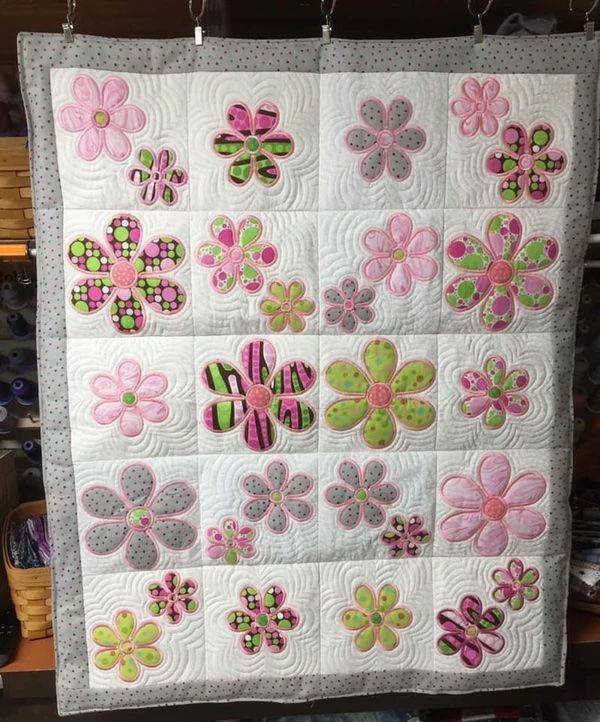Creating an applique floral quilt is more than just a craft—it’s an expression of artistry and tradition stitched into fabric. Right from the first cut to the final seam, every moment spent quilting carries the warmth of handmade passion and detailed creativity. If you’re searching for a satisfying and enduring sewing project that celebrates color, nature, and fabric art, the applique floral quilt is the perfect journey to take.
This quilt style stands out for its elegant fusion of applique techniques and floral themes, where flowers are carefully cut, shaped, and sewn onto a quilt top. These decorative pieces add dimension and charm, transforming a basic blanket into a stunning textile masterpiece. Whether you’re a beginner exploring hand sewing or an advanced quilter with a flair for design, this craft welcomes every level of maker with open arms.
In this article, we’ll guide you through the essentials of designing and creating your own applique floral quilt, including techniques, fabric choices, layout tips, and how to infuse personal style into every petal and stitch. You’ll also learn why this form of quilting remains a beloved favorite in both modern and traditional homes.

What Is an Applique Floral Quilt?
An applique floral quilt combines the art of applique with the beauty of botanical patterns. But what exactly does that mean? In essence, applique involves sewing pieces of fabric onto a larger background to create decorative designs. When the focus is on floral shapes—leaves, blooms, stems, or vines—it becomes a floral applique quilt.
This technique has deep roots in quilting history and has been cherished by many cultures as a way to tell stories through fabric. Unlike traditional piecing, where blocks are sewn together edge to edge, applique lets you layer shapes freely, giving the quilt a sculpted, textural feel. It’s a method that allows great freedom in design and offers limitless possibilities.
The floral aspect often includes roses, daisies, lilies, and even abstract botanical patterns. Some quilts are bold and bright with large blossoms, while others are delicate, soft-toned and subtle. This flexibility allows you to tailor your quilt to any aesthetic—from vintage farmhouse to modern minimalist.
Materials and Fabric Choices
When starting an applique floral quilt, choosing the right fabric is a foundational step. For both base fabric and applique pieces, high-quality 100% cotton is widely preferred. Cotton is durable, easy to sew, and comes in endless patterns and shades, making it ideal for both structure and decoration.
You’ll also need a reliable background fabric. Many quilters opt for light or neutral tones like cream, white, or soft pastels to ensure the floral designs truly pop. But don’t be afraid to experiment with bold backgrounds if you’re going for a more dramatic look.
Stabilizers and fusible webbing can also enhance the process, especially for beginners. These materials help hold the floral shapes in place before sewing, making your work smoother and more accurate. If you’re hand-stitching, embroidery floss or quilting thread adds a beautiful touch. For machine applique, a zigzag or satin stitch works wonderfully to secure the edges.
Techniques for Applique Success
One of the best aspects of making an applique floral quilt is that there are several techniques to explore, each with its own personality. You can choose hand applique for a traditional, heirloom-style finish or machine applique for speed and precision.
Hand applique involves turning the raw edges of your floral pieces under and stitching them onto the quilt top using invisible or decorative stitches. This technique takes time but yields a soft, classic appearance. It’s perfect for those who love the meditative nature of slow stitching.
On the other hand, machine applique offers a quick solution. You can use fusible web to temporarily bond the floral shapes to the fabric, then secure them with decorative stitching on your sewing machine. This method is especially useful for modern quilters who want to create clean edges and bold motifs quickly.
There’s also raw-edge applique, where edges aren’t turned under. Instead, they are left exposed and often fray slightly over time, adding texture and charm to the quilt. This is a popular choice for artistic and rustic quilt styles.
Designing Your Floral Layout
The layout of your applique floral quilt is where your creativity takes center stage. You can go for a uniform, repeating pattern or scatter different types of flowers throughout the quilt for a whimsical garden look. Either way, sketching your design beforehand helps bring your vision to life.
Start by visualizing the scale of your flowers. Do you want large, bold blooms that dominate each block, or smaller, daintier flowers that weave across the surface like a vine? Consider your color palette and how different florals will complement one another. A balance of warm and cool tones can create visual harmony.
Symmetry often brings a formal, structured look, while asymmetry can evoke natural movement and a more artistic feel. Try combining different types of flowers—roses with wildflowers, for instance—to create contrast and visual interest. Leaves and stems add flow and can connect each bloom across the quilt top like a real garden path.
If you’re making a wall hanging or a baby quilt, a central bouquet design can look stunning. For full-size bed quilts, you might want to divide your floral pieces among blocks or sashes for better distribution.
Stitching and Finishing Tips
Once you’ve placed your flowers, it’s time to stitch. Be sure to secure each piece tightly to ensure durability through washing and use. Whether using hand stitches or machine techniques, neatness and consistency are key. Take your time to pivot around curves and secure points carefully.
Layering your quilt with batting and backing is the next step. You can hand quilt around your floral shapes to make them puff slightly and stand out, or use free-motion quilting to trace leafy vines and swirling petals. Both methods add extra dimension and beauty to your quilt.
Binding is the final stage, and choosing the right edge finish enhances your overall design. A floral or solid binding that complements your applique colors works beautifully. Once finished, your applique floral quilt will not only be a functional piece but also a stunning artistic achievement.
Applique Floral Quilt
What is the best fabric for floral applique quilts?
100% cotton is the most recommended fabric due to its ease of use, durability, and wide variety of colors and patterns.
Can I use a sewing machine for applique quilts?
Yes, machine applique is a popular method that allows for speed and precision, especially useful for large projects.
Is applique quilting suitable for beginners?
Absolutely. Starting with simple floral shapes and using fusible web can help beginners ease into the process confidently.
What are some common floral patterns used in these quilts?
Roses, tulips, daisies, lilies, and abstract botanical designs are commonly used in applique floral quilts.
How do I keep my applique from fraying?
Turning edges under or using fusible web and tight stitching (like a satin stitch) can help prevent fraying.
How should I wash and care for an applique quilt?
It’s best to hand wash or use a delicate machine cycle with cold water. Avoid harsh detergents and always air dry when possible.
Creating an applique floral quilt is a beautiful way to blend creativity with craftsmanship. Throughout this article, you’ve learned how to choose materials, apply techniques, design floral layouts, and finish your quilt with care. Whether your goal is to decorate your home, gift a loved one, or simply enjoy the process of slow creation, this type of quilting offers fulfillment and lasting beauty.
We’d love to hear your thoughts! What inspired your floral quilt project? Feel free to leave your opinion and suggestions in the comments—your feedback helps us continue sharing ideas and patterns that spark joy.
